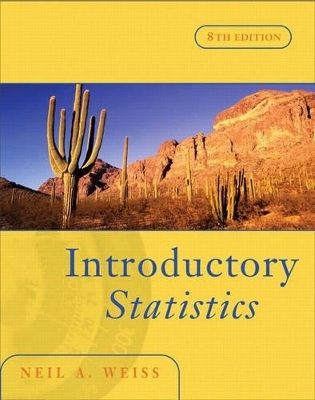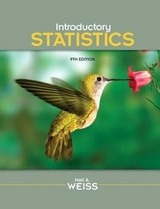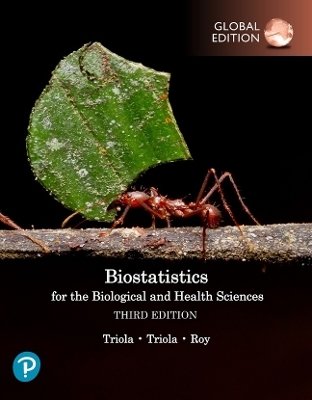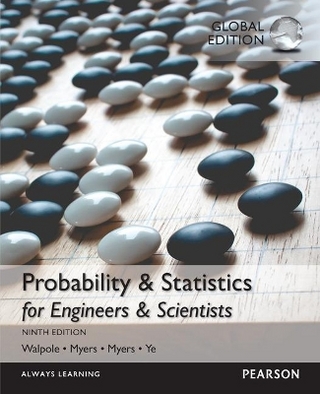
Introductory Statistics
Pearson
978-0-321-39361-6 (ISBN)
- Titel erscheint in neuer Auflage
- Artikel merken
This new edition continues Weiss’s tradition of cutting-edge statistical pedagogy and seamless integration of technology, and includes hundreds of new exercises with carefully cited data from journals, magazines, newspapers, and Web sites.
Introductory Statistics, Eighth Edition, contains a parallel presentation of the P-value and critical value approaches to hypothesis testing and promotes active learning and critical thinking, particularly in the exercises and end-of-chapter projects. The scope and flexibility of this Weiss text make it suitable for a one- or two-semester course.
Datasets and other resources (where applicable) for this book are available here.
Neil A. Weiss received his Ph.D. from UCLA in 1970 and subsequently accepted an assistant-professor position at Arizona State University (ASU), where he was ultimately promoted to the rank of full professor. Dr. Weiss has taught statistics, probability, and mathematics–from the freshman level to the advanced graduate level–for more than 30 years. In recognition of his excellence in teaching, he received the Dean’s Quality Teaching Award from the ASU College of Liberal Arts and Sciences. Dr. Weiss’ comprehensive knowledge and experience ensures that his texts are mathematically and statistically accurate, as well as pedagogically sound. In addition to his numerous research publications, Dr. Weiss is the author of A Course in Probability (Addison-Wesley, 2006). He has also authored or coauthored books in finite mathematics, statistics, and real analysis, and is currently working on a new book on applied regression analysis and the analysis of variance. His texts–well known for their precision, readability, and pedagogical excellence–are used worldwide. Dr. Weiss is a pioneer of the integration of statistical software into textbooks and the classroom, first providing such integration over 20 years ago in the book Introductory Statistics (Addison-Wesley, 1982). Weiss and Addison-Wesley continue that pioneering spirit to this day with the inclusion of some of the most comprehensive Web sites in the field. In his spare time, Dr. Weiss enjoys walking, studying and practicing meditation, and playing hold ’em poker. He is married and has two sons.
Preface
Supplements List
Data Sources
Part I: Introduction
Chapter 1 The Nature of Statistics
1.1 Statistics Basics
1.2 Simple Random Sampling
1.3 Other Sampling Designs*
1.4 Experimental Designs*
Part II: Descriptive Statistics
Chapter 2 Organizing Data
2.1 Variables and Data
2.2 Grouping Data
2.3 Graphs and Charts
2.4 Distribution Shapes
2.5 Misleading Graphs
Chapter 3 Descriptive Measures
3.1 Measures of Center
3.2 Measures of Variation
3.3 The Five-Number Summary; Boxplots
3.4 Descriptive Measures for Populations; Use of Samples
Part III: Probability, Random Variables, and Sampling Distributions
Chapter 4 Probability Concepts
4.1 Probability Basics
4.2 Events
4.3 Some Rules of Probability
4.4 Contingency Tables; Joint and Marginal Probabilities*
4.5 Conditional Probability*
4.6 The Multiplication Rule; Independence*
4.7 Bayes’s Rule*
4.8 Counting Rules*
Chapter 5 Discrete Random Variables*
5.1 Discrete Random Variables and Probability Distributions*
5.2 The Mean and Standard Deviation of a Discrete Random Variable*
5.3 The Binomial Distribution*
5.4 The Poisson Distribution*
Chapter 6 The Normal Distribution
6.1 Introducing Normally Distributed Variables
6.2 Areas Under the Standard Normal Curve
6.3 Working with Normally Distributed Variables
6.4 Assessing Normality; Normal Probability Plots
6.5 Normal Approximation to the Binomial Distribution*
Chapter 7 The Sampling Distribution of the Sample Mean
7.1 Sampling Error; the Need for Sampling Distributions
7.2 The Mean and Standard Deviation of the Sample Mean
7.3 The Sampling Distribution of the Sample Mean
Part IV: Inferential Statistics
Chapter 8 Confidence Intervals for One Population Mean
8.1 Estimating a Population Mean
8.2 Confidence Intervals for One Population Mean When σ is Known
8.3 Margin of Error
8.4 Confidence Intervals for One Population Mean When σ is Unknown
Chapter 9 Hypothesis Tests for One Population Mean
9.1 The Nature of Hypothesis Testing
9.2 Terms, Errors, and Hypotheses
9.3 Hypothesis Tests for One Population Mean When σ is Known
9.4 Type II Error Probabilities; Power*
9.5 P-Values
9.6 Hypothesis Tests for One Population Mean When σ is Unknown
9.7 The Wilcoxon Signed-Rank Test*
9.8 Which Procedure Should Be Used?*
Chapter 10 Inferences for Two Population Means
10.1 The Sampling Distribution of the Difference Between Two Sample Means for Independent Samples
10.2 Inferences for Two Population Means, Using Independent Samples: Standard Deviations Assumed Equal
10.3 Inferences for Two Population Means, Using Independent Samples: Standard Deviations Not Assumed Equal
10.4 The Mann—Whitney Test*
10.5 Inferences for Two Population Means, Using Paired Samples
10.6 The Paired Wilcoxon Signed-Rank Test*
10.7 Which Procedure Should Be Used?*
Chapter 11 Inferences for Population Standard Deviations*
11.1 Inferences for One Population Standard Deviation*
11.2 Inferences for Two Population Standard Deviations, Using Independent Samples*
Chapter 12 Inferences for Population Proportions
12.1 Confidence Intervals for One Population Proportion
12.2 Hypothesis Tests for One Population Proportion
12.3 Inferences for Two Population Proportions
Chapter 13 Chi-Square Procedures
13.1 The Chi-Square Distribution
13.2 Chi-Square Goodness-of-Fit Test
13.3 Contingency Tables; Association
13.4 Chi-Square Independence Test
Part V: Regression, Correlation, and ANOVA
Chapter 14 Descriptive Methods in Regression and Correlation
14.1 Linear Equations With One Independent Variable
14.2 The Regression Equation
14.3 The Coefficient of Determination
14.4 Linear Correlation
Chapter 15 Inferential Methods in Regression and Correlation
15.1 The Regression Model; Analysis of Residuals
15.2 Inferences for the Slope of the Population Regression Line
15.3 Estimation and Prediction
15.4 Inferences in Correlation
15.5 Testing for Normality*
Chapter 16 Analysis of Variance (ANOVA)
16.1 The F-Distribution
16.2 One-Way ANOVA: The Logic
16.3 One-Way ANOVA: The Procedure
16.4 Multiple Comparisons*
16.5 The Kruskal—Wallis Test*
Part VI: Multiple Regression and Model Building; Experimental Design and ANOVA (On The WeissStats CD-ROM)
Module A Multiple Regression Analysis
A.1 The Multiple Linear Regression Model
A.2 Estimation of the Regression Parameters
A.3 Inferences Concerning the Utility of the Regression Model
A.4 Inferences Concerning the Utility of Particular Predictor Variables
A.5 Confidence Intervals for Mean Response; Prediction Intervals for Response
A.6 Checking Model Assumptions and Residual Analysis
Module B Model Building in Regression
B.1 Transformations to Remedy Model Violations
B.2 Polynomial Regression Model
B.3 Qualitative Predictor Variables
B.4 Multicollinearity
B.5 Model Selection: Stepwise Regression
B.6 Model Selection: All Subsets Regression
B.7 Pitfalls and Warnings
Module C Design of Experiments and Analysis of Variance
C.1 Factorial Designs
C.2 Two-Way ANOVA: The Logic
C.3 Two-Way ANOVA: The Procedure
C.4 Two-Way ANOVA: Multiple Comparisons
C.5 Randomized Block Designs
C.6 Randomized Block ANOVA: The Logic
C.7 Randomized Block ANOVA: The Procedure
C.8 Randomized Block ANOVA: Multiple Comparisons
C.9 Friedman’s Nonparametric Test for the Randomized Block Design*
APPENDIXES
Appendix A: Statistical Tables
I. Random numbers
II. Areas under the standard normal curve
III. Normal scores
IV. Values of tα
V. Values of Wα
VI. Values of Mα
VII. Values of χα2
VIII. Values of Fα
IX. Critical values for a correlation test for normality
X. Values of q0.01
XI. Values of q0.05
XII. Binomial probabilities
Appendix B Answers to Selected Exercises
Index
Photo Credits
Indexes for Biographical Sketches & Case Studies
*indicates an optional section
| Erscheint lt. Verlag | 2.2.2007 |
|---|---|
| Sprache | englisch |
| Maße | 263 x 222 mm |
| Gewicht | 2104 g |
| Themenwelt | Mathematik / Informatik ► Mathematik ► Statistik |
| ISBN-10 | 0-321-39361-9 / 0321393619 |
| ISBN-13 | 978-0-321-39361-6 / 9780321393616 |
| Zustand | Neuware |
| Haben Sie eine Frage zum Produkt? |
aus dem Bereich


